China National Post and Postage Stamp Museum
Located at No. 6, West Gongyuan Street inside Jianguomen Gate, China National Post and Postage Stamp Museum displays the origins of the country's postal service, development, and over 300,000 stamps from all over the world. The exhibition area is about 6,578 square yards (5,500 square meters) with a total of over 100,000,000 items on exhibit. The collection in China National Post and Postage Stamp Museum includes some really rare items, such as Penny Black and Large Dragon - the first stamp of the world and China respectively.
Stamp Hall
Postal Service Hall
Collection Treasures
China's first set of stamps - Large Dragon
Issued by the Qing Customs in 1878, it is also known as the Customs Large Dragon. Being the first official set, it marks the start of China's modern postal system.
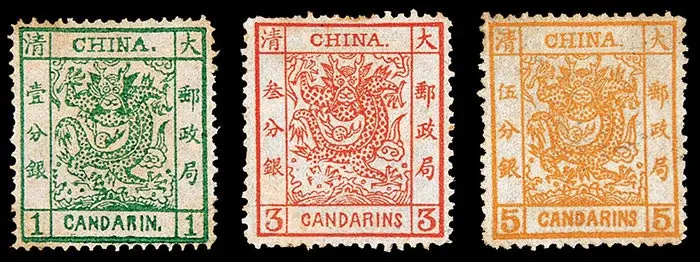 |
First set using watermark paper - Small Dragon
Issued in 1885, this was the first time that special watermark paper, a Taichi pattern illumination, was used in printing.
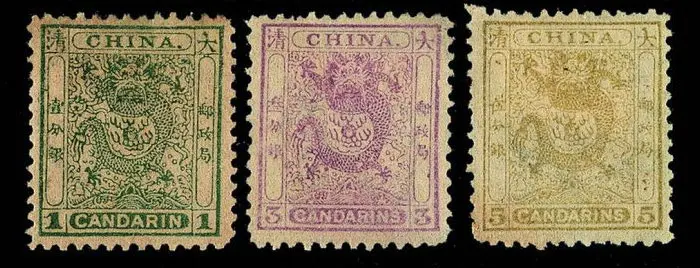 |
China's first commemorative set - Longevity Stamp
In 1894, the Qing Customs issued its last series, the Longevity series, to commemorate the 60th birthday of Empress Dowager Cixi, the real ruler of the Qing Dynasty at that time.
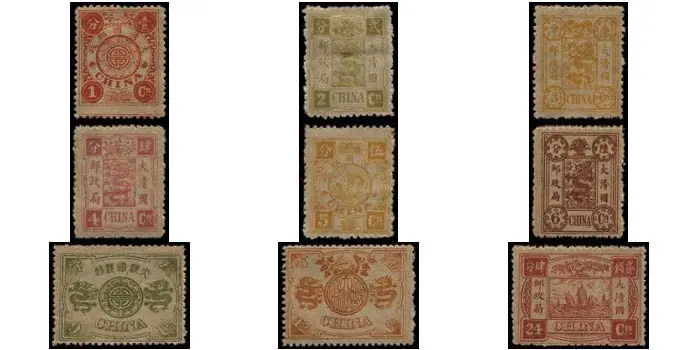 |
First overprinted set - Red Revenue
In 1896, the Qing Dynasty Official Post Office was established. In 1897, to deal with the postage change caused by the reform of the monetary system, the Official Post Office surcharged a series of unissued revenue stamps and released them for postage use.
 |
![]() Republic of China (1912 – 1949)
Republic of China (1912 – 1949)
First set issued by government post office – Provisional Neutrality
The postal system was not sufficiently established to issue the official set right after the foundation of the Republic of China in 1912. In order to distinguish from the collapsed Qing Dynasty, Eight Chinese characters, which mean Provisional Neutrality and the Republic of China, were overprinted on the old ones issued by the Qing Post Office. There were 46 surcharges in total, and 28 of them never issued, making the whole set a really rare treasure.
 |
First definitive set issued by government post office – Sailing Boat
This was the longest used set in this period. Different patterns convey different meanings - the sailing boat pattern indicates the development of transportation, the harvest before the Temple of Agriculture emphasizes agriculture as the country's foundation, while Guozijian, the Imperial Academy represents education. They are collectively called Sailing Boat.
 |
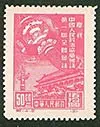
![]() People's Republic of China (PRC) (1949 - present)
People's Republic of China (PRC) (1949 - present)
First commemorative set of PRC
In memory of the foundation of the PRC on October 1, 1949, the commemorative set was issued seven days later. It depicts the grand founding ceremony with the images of parading processions, mighty tanks and roaring planes.
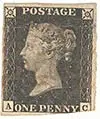
![]() Collections from Foreign Countries
Collections from Foreign Countries
World's First Stamp – Penny Black
It was issued in Britain on May 6, 1840, using black ink with the face value of one penny, so it was called Penny Black. The picture on it is the profile of Queen Victoria.
How to Get to National Post and Postage Stamp Museum
2. Take bus 1, 52, 63, 120, 126, 140, 142 or 637 and get off at Beijing Zhankou Dong Station. Then walk northward along West Gongyuan Street to the gate.
Beijing Bus / Subway Search
| Admission Fee | Free |
| Opening Hours | Tuesday to Sunday: 9:00 - 16:00; Closed on Monday. |